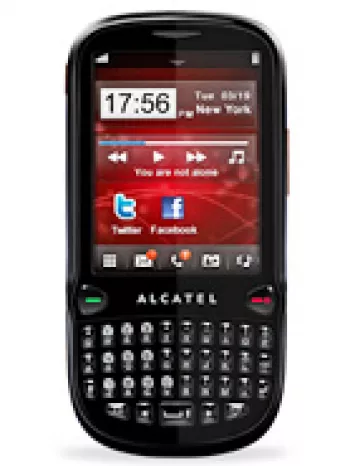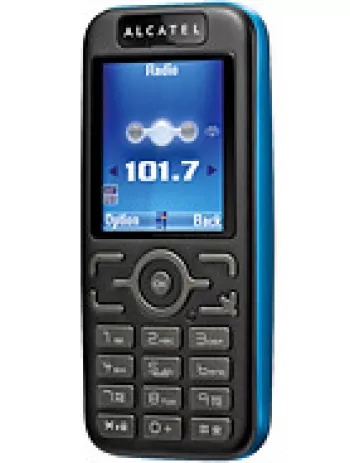
Overview of Alcatel OT-807
The Alcatel OT-807, introduced in 2011 and discontinued shortly after its release, is a feature phone boasting a design and functionality that cater to users seeking basic mobile capabilities rather than the full array of smart features found in modern smartphones. Equipped with a QWERTY keyboard and a touchscreen, the OT-807 exemplifies a transitional phase in mobile technology towards more interactive user interfaces.
Design and Build
The Alcatel OT-807 is crafted with dimensions of 118.5 x 59 x 12.2 mm and weighs 105 grams, offering a compact and lightweight structure. Its design integrates a resistive TFT touchscreen and a full QWERTY keyboard, providing users with both touch and type functionality. It employs a Mini-SIM format, which was prevalent during the time of its release.
Display
This device features a 2.8-inch resistive touchscreen with a resolution of 320 x 240 pixels. Offering a pixel density of approximately 143 ppi, the display supports 256K colors, bringing moderate clarity and color representation for basic tasks and interface navigation.
Camera Capabilities
The OT-807 is equipped with a single 2 MP rear camera capable of capturing photos and recording videos. While it lacks advanced camera functionalities that are common in present-day smartphones, it provides essential photo-taking capabilities for documenting everyday moments.
Hardware and Performance
Under the hood, the device is powered by a 208 MHz processor. This level of processing power is sufficient for handling basic phone activities such as calling, texting, and light application usage. As a feature phone, its focus is less on high-performance specifications and more on fundamental communication features.
Storage and Memory
The Alcatel OT-807 includes an internal storage capacity of 60MB. However, users can expand the storage via a dedicated microSDHC card slot for additional data storage, making it feasible to store more messages, contacts, and basic multimedia files. Phonebook capacity includes photocall functionality, and call records are maintained adequately.
Battery Life
Incorporated with a removable Li-Ion 850 mAh battery, the OT-807 ensures relatively decent longevity for a feature phone. It offers up to 650 hours of standby time, 9 hours of talk time, and up to 22 hours of music playback, providing consistent performance throughout the day.
Network and Connectivity
The phone operates on GSM networks, supporting GSM 850/1900 bands. Data connectivity options include GPRS (Class 12) and EDGE (Class 12). For wireless connectivity, it offers WLAN 802.11 b/g, Bluetooth 2.0 with A2DP, and microUSB 2.0 for charging and data transfer. However, it does not support positioning services such as GPS.
Audio and Multimedia
Audio functionalities include a loudspeaker and a 3.5mm audio jack, offering users the ability to enjoy music and radio via Stereo FM radio with RDS support. While the multimedia capabilities may not match those of smartphones, they suffice for basic entertainment needs.
Software and Applications
Running on a feature phone operating system, the OT-807 provides basic applications including messaging options such as SMS, MMS, Email, and IM. Internet browsing is possible via WAP 2.0/xHTML and HTML browsers. Java support through MIDP 2.0 enables additional application installations compatible with the platform.
Miscellaneous Features
Available in colors like Cherry red, Dark chrome, and Orange, the device allows users to express personal preferences. Despite the absence of advanced sensors, the OT-807 meets the essential requirements for a reliable communication device in its era.
Conclusion
The Alcatel OT-807 serves as a reflection of the transitional cellphone era, where basic communication and convenience were focal points. It caters to users looking for essential features in a mobile device with a blend of tactile and touchscreen inputs. Though it might not compete with modern smartphones, it holds its ground as a dependable and straightforward mobile communication tool.
Key Features of Alcatel OT-807
- Supports GSM technology with GPRS Class 12 and EDGE Class 12
- Compact dimensions: 118.5 x 59 x 12.2 mm, weighs 105 g
- Full QWERTY keyboard for easy typing
- 2.8-inch TFT resistive touchscreen with 256K colors
- Expandable memory via microSDHC card slot
- 2 MP main camera with video capability
- Wi-Fi 802.11 b/g connectivity
- Bluetooth 2.0 with A2DP support
- Stereo FM radio with RDS
- MicroUSB 2.0 for data transfer
- Removable Li-Ion 850 mAh battery with up to 9 hours talk time
Drawbacks of Alcatel OT-807
- The device supports only 2G GSM technology, which limits high-speed internet access and modern network features.
- Outdated resistive touchscreen technology can be less responsive compared to modern capacitive touchscreens.
- Limited screen size of 2.8 inches makes it less suitable for media consumption and browsing.
- The low screen resolution of 320 x 240 pixels results in a low pixel density (~143 ppi), affecting display clarity.
- Very low internal memory of 60MB, which requires frequent use of a microSDHC card for additional storage.
- Weak processing power with a CPU of only 208 MHz, leading to sluggish performance and limited multitasking capabilities.
- The main camera is only 2 MP, providing poor image quality by today's standards.
- Lack of a front-facing selfie camera limits video calling and self-portrait capabilities.
- No positioning systems such as GPS are available, affecting navigation functionalities.
- The device has been discontinued, which might result in limited support and availability of spare parts.
View Also
More Phones
All Rights Reserved +14268 Phones © Mobilawy 2025

























